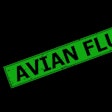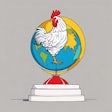
Earlier this month, Kim Jong Un, the leader of the Democratic People’s Republic of Korea (North Korea), called for the country’s poultry output to be expanded.
A substantial change to the sector is required to lift the population’s standard of living, he said, according to the Yonhap news agency.
The source cited the Korean Central News Agency, which reported an official visit by Kim and his daughter to the Kwangchon poultry farm earlier this month. At the premises in Hwanghae province in the southwest of country, he announced that a similar farm is planned for this year — to be located near the capital city, Pyongyang.
According to the same source, North Korea has been focusing efforts to increase domestic grain production recently, following reported chronic food shortages.
North Korea’s latest chicken farm
At last, the Kwangchon chicken farm is operational, reported 38North earlier this week.
It has been a project personally initiated by Kim Jong Un as far back as 2019. Held up as a model for the development of country’s poultry production, it was expected to produce thousands of tons of meat, and tens of millions of eggs. The leader described the then-current state of the sector as backward.
Two weeks ago — a few days after the leader’s visit — the farm received its official inauguration.
The same source reports that the farm comprises long sheds. Images of the facility show multiple rows of battery cages containing laying hens. The farming system has been described as both “intensive” and “automatic.” Eggs are collected on belts at the front of each cage.
A large solar array on the site provides power for the farm.
Around two years ago, two other chicken farms in North Korea are reported to have been renovated.
In September of last year, the same source reported that the Kwangchon farm comprised 13 poultry houses of different sizes, which were calculated to accommodate 170,000 chickens. Other buildings on the site were thought to include a hatchery, a slaughterhouse, and egg and meat processing equipment. A five-story building was likely to be the location for administrative and laboratory functions, and there appeared to be housing for workers.
More on North Korea’s poultry sector
Total numbers of poultry farms and bird numbers are uncertain, according to the earlier 38North report. However, its digital survey revealed 35 likely locations, mainly in the west of the country. Most of these were already constructed 20 years ago, and few show signs of expansion since that time.
Annual chicken meat production amounted to 10,882 metric tons (mt). This is according to the statistics arm of the United Nations’ Food and Agriculture Organization, FAOstat for 2022, the most recent year for which data have been published. In the same period, duck meat output was estimated to be 13,878mt, and chicken eggs at almost 125,000mt.
The World Bank puts the North Korea’s human population at a little over 26 million in 2022.
The presence of highly pathogenic avian influenza in North Korea was confirmed by the veterinary authority to the World Organisation for Animal Health in 2005 and 2014.
As yet, the latter outbreak series, which was linked to the H5N1 virus serotype, has not been officially closed. Three outbreaks were reported — two at chicken factories and one in a village poultry flock — all in March and April of 2014.















